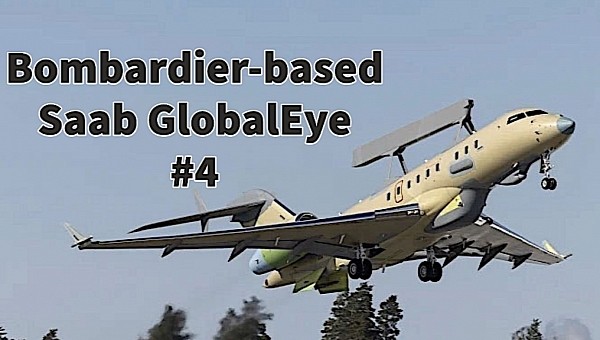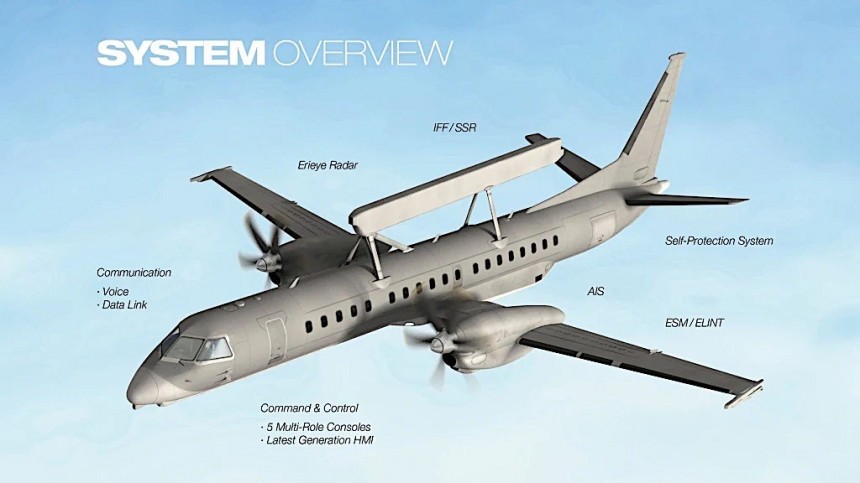Because of an airplane the military calls the E-3 Sentry, every time we average Joes hear the word AWACS we immediately imagine an aircraft with a flying saucer of sorts attached to its back. But that is not the only configuration required for a warning and control system to work, and the Bombardier Global we have here is ample proof of that.
AWACS means Airborne Warning and Control System, and it’s a term that has been with us for decades now. More modern terminology refers to these kinds of tools as Airborne Early Warning & Control (AEW&C), but the bottom line is the same: they are specially converted aircraft used mostly by the military for both surveillance and command and control of friendly forces.
The Sentry, in essence, a modified Boeing 707, has been with us since 1977, and it may very well be considered the first of its kind, hence our tendency to associate all AWACS planes with its strange silhouette. But there are other such machines out there, including the E-7 Wedgetail that will soon replace the Sentry in the USAF arsenal, and the Saab GlobalEye we’re here to discuss today.
The GlobalEye is in fact a Bombardier airplane of the Global variety, modified including with the fitting of something that looks like a straight metal appendix on the upper side of its fuselage. It’s a design similar, but somewhat stranger than that of the Wedgetail. Such a design is required because that strange metal appendix holds the Saab gear needed for the plane to conduct its missions, namely the Erieye radar.
Erieye is capable of keeping under surveillance an area spanning 500,000 square km (193,000 square miles) on the horizontal and 60,000 feet (18 km) on the vertical. When mounted on the Bombardier, it can be used for “long-range detection and identification of objects in air, at sea and over land,” but also to help coordinate rescue missions in the aftermath of natural disasters.
As for the plane itself, it’s largely the stock one as far as capabilities go. Depending on the variant, it can fly at speeds of up to 956 kph (594 mph) and for distances of over 12,200 km (7,580 miles), powered by a pair of Rolls-Royce engines.
The GlobalEye program came about in 2016, so we presently don't have all that many planes of this variety flying in the skies of our world. In fact, Saab only announced this week the first flight of the fourth airplane in the fleet, at the company’s airfield in Sweden.
The United Arab Emirates Air Force currently fields all three other airplanes, and that’s where this fourth plane is heading as well, together with the fifth one currently in the works. The cost of a single such plane is estimated at $710 million.
The Sentry, in essence, a modified Boeing 707, has been with us since 1977, and it may very well be considered the first of its kind, hence our tendency to associate all AWACS planes with its strange silhouette. But there are other such machines out there, including the E-7 Wedgetail that will soon replace the Sentry in the USAF arsenal, and the Saab GlobalEye we’re here to discuss today.
The GlobalEye is in fact a Bombardier airplane of the Global variety, modified including with the fitting of something that looks like a straight metal appendix on the upper side of its fuselage. It’s a design similar, but somewhat stranger than that of the Wedgetail. Such a design is required because that strange metal appendix holds the Saab gear needed for the plane to conduct its missions, namely the Erieye radar.
As for the plane itself, it’s largely the stock one as far as capabilities go. Depending on the variant, it can fly at speeds of up to 956 kph (594 mph) and for distances of over 12,200 km (7,580 miles), powered by a pair of Rolls-Royce engines.
The GlobalEye program came about in 2016, so we presently don't have all that many planes of this variety flying in the skies of our world. In fact, Saab only announced this week the first flight of the fourth airplane in the fleet, at the company’s airfield in Sweden.
The United Arab Emirates Air Force currently fields all three other airplanes, and that’s where this fourth plane is heading as well, together with the fifth one currently in the works. The cost of a single such plane is estimated at $710 million.











